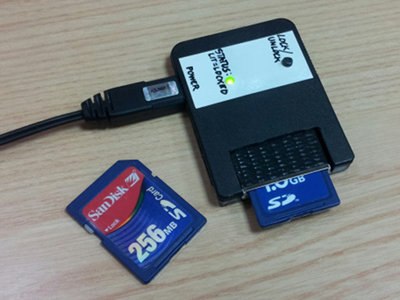Attiny85-based device to enable and disable write-protection on any SD card.

Based on sdlocker by Karl Lunt, see http://www.seanet.com/~karllunt/sdlocker.html
I routinely use USB drives loaded with software tools and benchmarks to diagnose and fix computers. I wanted a way to protect those drives from viruses, malware, filesystem corruption and accidental erase.
USB drives with a write-protect switch do exist, but are hard to find and expensive. Full-sized SD cards have a slider tab to write-protect them, but it actually does nothing - it's up to the card reader to report it to the OS, and it's up to the OS to decide whether to comply and mount the card read-only or not. Most of them simply ignore it, so SD cards may be overwritten regardless of the write-protect tab.
The sdlocker allows me to truly write-protect any SD card by toggling the TMP_WRITE_PROTECT bit on the flash memory controller of the card itself. Together with a USB card reader, this write-protected card can then be used as a read-only USB drive.
This is my own fork of the original sdlocker, tailored to suit my needs - smaller, simpler, and USB-powered.
- Ported from Atmega328 to Attiny85
- Removed all the UART code and unused functions
- Rewrote the user interface (1 button, 1 LED)
The LED shows the state of the inserted card at all times:
- Steady off: card is unlocked (writable)
- Steady on: card is locked (write-protected)
- Blinking, fast: device is reading the card
- Blinking, slow: card is faulty or not properly inserted
Holding the button down (over half a second) toggles the write-protection of the inserted card.
-
See sdlocker-tiny.cpp for ASCII schematic.
-
The button and LED share the same pin on the Attiny.
-
The RESET pin on the Attiny is left unconnected. It could be turned into another I/O pin by changing the appropiate fuse, but flashing the chip after that (even to change the fuse back) would require a HV programmer.
-
The SD card socket has a card-detect switch that shorts a pin to ground when a card is inserted.
I used this pin as ground to cut the power to the device while there is no card. -
To turn the 5V from USB into 3.3V, I used a Texas Instruments LM3940 + 2 capacitors
(see the LM3940 datasheet, Typical application) -
Both the Attiny85 and the SD card run on 3.3V. Do not power them with 5V from USB!
The Attiny can take it, but the card will be destroyed.
The provided makefile uses avr-gcc and avrdude. Edit it to match your programmer.
Run make to compile and make program to flash.